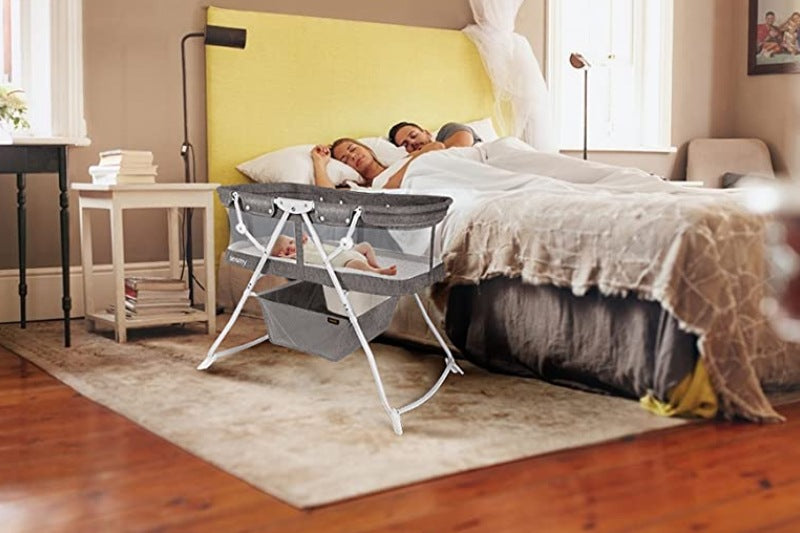
Cradle Vs Bassinet: Which One Should You Buy?
Are you expecting a child and unsure whether to purchase a bedside bassinet or a cradle? You want to make the best decision for your child's safety while ensuring that the baby cradle or bassinet you choose fits your budget and lifestyle. Here's what you need to know about the differences between a bassinet and a cradle and how you can narrow down your options.
What is a Cradle?
A cradle is traditionally a small, semi-portable piece of furniture in which a baby sleeps. They typically have rocker-style legs or hang from a frame, similar to a hammock.
Today's cradle alternatives are a little different. The standard, modern version of a cradle, also known as a playpen or play yard, has many uses and options and is primarily designed for the newborn sleeper.
Some models include a changing table. The most important feature is that the walls are higher than in previous models, making transitioning easier as your baby grows.

Pros
Ensure Adequate Airflow
The spaces between cradle slats allow air to circulate, creating a cool and soothing environment for your baby. Not only will this make your baby happier, but good airflow may reduce your baby's risk of SIDS by up to 70%.
Generally Sturdier
Cradles are more durable than baby bassinets and are built to last. This means they are less likely to collapse while your child is inside. Furthermore, children with greater mobility will have difficulty climbing out of them, protecting them from potential falls.
Cons
Mom Might Find It Uncomfortable
The height of a cradle may be difficult for mothers who have back issues, are recovering from a C-section, or are on the shorter side.
If you are unsteady when leaning over the railings to lay your baby down, these factors could also increase the chance of dropping them.
What is a Bassinet?
A bassinet, also known as a cosleeper, is a small, portable piece of baby sleeping furniture with several useful features. They are typically designed to attach to the side of an adult's bed for security and closeness during the night.
They may or may not include a stand, wheels, and a handle across the top. They are a great way to keep your baby close, move him around, and keep an eye on him during the night or while sleeping at any time.

Pros
They Can Reduce SIDS
To help reduce the risk of SIDS, the Centers for Disease Control and Prevention recommends that babies sleep in the same room as their parents but in a different bed. Because of its small size, a bassinet can be an excellent choice for keeping your baby close throughout the night.
They Move With You
Many bassinets have wheels, but they're portable and lightweight, even if they don't. They are an excellent choice if you want your baby to sleep safely close to you at all times, in every room of the house, due to their portability.
Improved New-Mommy Mobility
Even getting up and moving around can be difficult for new mothers, let alone bending over the rails of a cradle to pick up a baby! Bassinets are lower in height and have lower sides. This makes it easier to lay down the baby and get them out.
Bassinets can be especially useful for mothers who have back problems or are recovering from a C-section.
Cons
Replacement Required
Bassinets are not designed to last for an extended period. Most bassinets have a weight limit of 15 to 20 pounds and, as previously stated, work well for babies aged 4 to 6 months. You will eventually need to transition your baby from a bassinet to a cradle.
Unless you intend to have more children in the future, it is only a temporary sleeping solution.
Aren't Economical
While bassinets are less expensive upfront, they will cost you more in the long run because you purchase two separate items.
Cost Control
If you don't intend to use your bassinet after your newborn has graduated to a baby cradle, consider selling it to a local second-hand baby boutique or another expecting mother, you know.
Difference Between a Cradle and a Bassinet
There are a few key differences between the two, and examining them closely may help you decide which is best.
Cost
Bassinets, on the whole, are less expensive than cradles. This is because they are designed to be used for a shorter period. A good bassinet can range in price from $60 to $135.
A mid-range cradle costs between $150 and $450 on average. A cradle mattress will range in price from $30 to $150.
This makes bassinets a good option for parents who cannot afford the initial cost of baby items and wish to postpone purchasing a cradle until their child is older.
Use Period
Bassinets typically last from 4 to 6 months, depending on your baby's size and level of mobility.
As an alternative, cradles can be considered a more long-term investment because they are built to last from when your baby is a newborn until they are ready for a larger bed.
How do you Choose Between Cradle and Bassinet?
When selecting a cradle or bassinet for your little bundle of joy, there are numerous factors to consider. Space, safety, budget, and style are just a few factors to consider when making such a large purchase.
We hope this information will help you (and your baby) rest a little easier, whether you want to spend less money upfront with a bassinet or invest in a cradle for the long term.
Related reading





